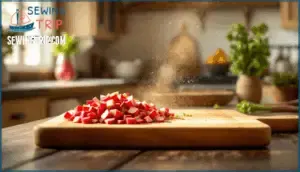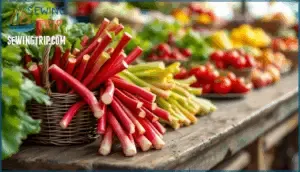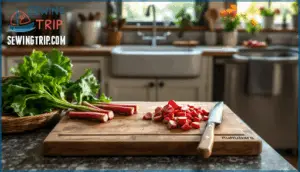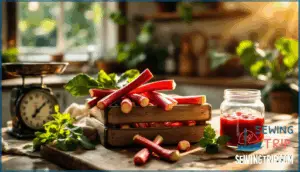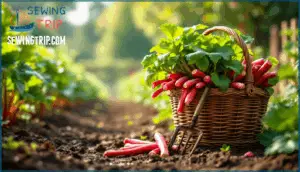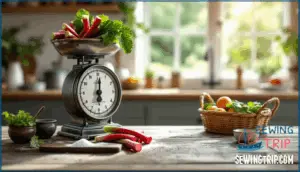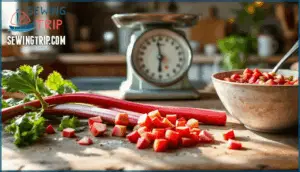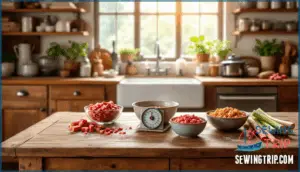This site is supported by our readers. We may earn a commission, at no cost to you, if you purchase through links.
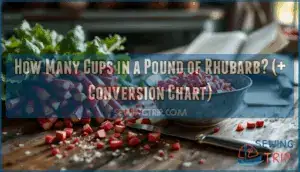
Here’s the straight answer: one pound of rhubarb gives you roughly three cups when chopped into half-inch pieces, though that shifts to two cups once cooked down. The difference between raw and cooked matters more than most recipes let on—stalk thickness, chopping size, and moisture content all play their part in turning pounds into cups.
Understanding these conversions means you’ll nail every rhubarb crisp, tart, and sauce without the guesswork that leaves you scrambling mid-recipe.
Table Of Contents
Key Takeaways
- One pound of fresh rhubarb yields roughly three cups when chopped into half-inch pieces, but this shrinks to two cups once cooked as the stalks soften and release moisture.
- A kitchen scale delivers more accurate measurements than volume-based cup conversions since rhubarb density varies with stalk thickness, moisture content, and how tightly pieces are packed.
- Stalk color doesn’t predict tartness—variety matters more than hue, so green stalks can taste sweeter than red ones, and selecting firm, crisp stalks with glossy skin ensures the best cooking results.
- Rhubarb leaves contain toxic oxalic acid and must always be discarded, while the edible stalks can be frozen raw in half-inch pieces for up to nine months without blanching.
Rhubarb Measurement Basics
Getting your rhubarb measurements right means the difference between a perfect pie and a watery disaster. The weight-to-volume ratio isn’t rocket science, but a few key conversions will save you from guesswork in the kitchen.
Here’s what you need to know about translating pounds into cups and why precision matters.
Rhubarb Weight Conversions
If you’ve ever been elbow-deep in a rhubarb recipe only to realize it calls for pounds when you’ve measured in cups—or vice versa—you’re not alone. Here’s what you need to know: one pound of rhubarb yields roughly three cups chopped raw or two cups cooked. That’s your conversion factor right there.
Keep these measurement tips in mind:
- Stalk thickness matters: Thicker stalks pack tighter, affecting volume measures
- Rhubarb density shifts: Moisture content changes weight metrics slightly
- Chopping size counts: Fine versus coarse cuts alter how rhubarb measurement conversion works in practice
Double-check your measurements—accurate weight metrics mean better results every time.
Metric Equivalents
Most recipes speak in pounds, but your measuring cups don’t—so here’s how metric conversions keep you on track. One pound of rhubarb equals 454 grams, while three cups chopped weighs roughly 300 grams. These conversion rates matter when adapting international recipes or verifying measurement standards align.
| Metric Standard | Conventional Equivalents |
|---|---|
| 454 grams | 1 pound rhubarb |
| 300 grams | 3 cups chopped |
Use conversion charts for precise volume measures and weight equivalents—your metric measures become second nature once you’ve got the numbers down.
Importance of Kitchen Scales
You don’t need a PhD in measurements to get rhubarb right, but a kitchen scale cuts through the guesswork completely. Digital scales deliver measurement precision that measuring cups can’t match—no compaction issues, no air pockets. When you’re converting pounds to cups or grams, accurate weighing eliminates recipe disasters before they happen. Scale calibration takes seconds, and weight conversion becomes foolproof.
- Measure by weight for consistent results every time
- Skip the mess of overfilled measuring cups
- Switch between pounds and metric instantly
- Trust your kitchen scale more than eyeballing volume
Cups in One Pound Rhubarb
One pound of fresh rhubarb breaks down to roughly 3 cups when chopped—though the actual number shifts depending on how thick your stalks are and how fine you cut them. Rhubarb density plays a role too: thicker stalks pack tighter, while moisture content affects weight measurement.
Once cooked, that same pound reduces to about 2 cups as the stalks soften and release liquid. Volume conversion gets simpler when you understand this shift—your cup equivalents drop by a third after cooking.
For precise rhubarb yield, use a kitchen scale rather than eyeballing measurement conversions.
Rhubarb Varieties and Selection
Not all rhubarb is created equal, and the variety you choose can affect your measurements and flavor. The color of the stalks doesn’t tell the whole story about tartness, and knowing what to look for at the market makes all the difference.
Here’s what you need to know about varieties and selection.
Cherry and Victoria Varieties
When you’re standing in the produce aisle trying to decide which rhubarb varieties to grab, ‘Cherry Red’ and ‘Victoria’ are two workhorses worth knowing. Cherry Red brings those gorgeous crimson stalks—red inside and out—with a sweeter flavor profile that makes measuring your pound of chopped rhubarb for desserts almost straightforward. Victoria, the old reliable, offers medium to large greenish-pink stalks with a balanced sweet-acidic taste that converts beautifully in measurement conversions, whether you need cups of raw or cooked rhubarb.
For the best results, understanding rhubarb variety characteristics is essential for choosing the right type for your recipe.
- Cherry Red: Crimson throughout, naturally sweeter—perfect when your rhubarb crisp recipe demands bold stalk colors
- Victoria: Dependable yields up to 90 pounds per plant with proper care, giving you control over harvest timing
- Flavor profiles matter: Choose based on whether you’re measuring for tart jams or mellower sauces
Stalk Color and Tartness
Most folks assume red stalks pack the punch, but here’s the kicker—stalk color is more smoke and mirrors than flavor fortune-teller. Rhubarb varieties dictate tartness, not rhubarb hue. Green stalks can taste sweeter than their crimson cousins, while stalk texture and firmness matter more for rhubarb measurement and conversion charts. Focus on variety when you’re planning your rhubarb cooking.
| Rhubarb Hue | Flavor Profile | Tartness Level |
|---|---|---|
| Deep Red | Sweet-Tart | Medium |
| Pink-Red | Balanced | Medium-High |
| Green | Mild-Tart | Variable |
| Greenish-Pink | Sweet-Acidic | Low-Medium |
Choosing Fresh Rhubarb
Smart shoppers grab rhubarb like they’re picking produce with purpose—firm stalks, glossy skin, and zero tolerance for limp greens signal the difference between a superb pie and a soggy disappointment. Fresh rhubarb demands crisp texture and vibrant color, whether crimson or jade. Harvest timing affects sweetness—early-season stalks bring tenderness, while later picks offer bolder tartness.
- Stalk selection: Choose 1–2 inch diameter stalks without blemishes or soft spots
- Color guide: Bright, consistent hue matters more than specific shade
- Freshness check: Snap a stalk—it should break cleanly with audible crunch
Preparing and Cooking Rhubarb
Before you start cooking with rhubarb, you need to know what’s edible and what’s not. The way you trim and chop the stalks affects both your measurements and your final dish.
Let’s break down how to prep this tart spring vegetable and get it ready for the pot.
Edible Parts of Rhubarb
When you slice into rhubarb, you’re working with stalks that contain all the flavor—but those broad, leafy greens attached to them are hiding a toxic secret. Rhubarb leaves contain dangerously high levels of oxalic acid, making them completely inedible. Don’t risk it—always discard them before cooking.
Your edible portions are the firm, crisp stalks. Whether you’ve got a pound of fresh harvest from the garden or market rhubarb ready for chopping, trim both ends of each stalk and toss those leaves immediately. Think of it like claiming your culinary prize while avoiding the hazard.
Once trimmed, you’ll have clean stalks ready to transform into cups of chopped rhubarb for pies, crisps, or jams. The weight-to-volume conversion matters here: that pound of stalks becomes roughly three cups when chopped, giving you precise measurements for any recipe. The stalks alone deliver that signature tart punch rhubarb’s famous for—no leaves required.
Trimming and Chopping Rhubarb
Strip away the leafy tops, grab a sharp knife, and you’re seconds away from transforming those ruby stalks into recipe-ready pieces that measure perfectly in your cup. Trim both stalk ends—those woody bits at the base and top won’t soften during cooking. Slice stalks lengthwise if they’re thicker than your thumb, then chop crosswise into uniform pieces.
Your chopping technique determines how that pound of rhubarb packs into measuring cups:
- Quarter-inch dice creates tightly packed cups with minimal air pockets—ideal for jams and sauces
- Half-inch chunks give you the standard three cups per pound conversion most recipes expect
- One-inch pieces work best for crisps where you want visible fruit texture
- Diagonal slicing adds visual appeal while maintaining consistent cooking times across all pieces
Cooking Methods and Tips
Your rhubarb stalks are prepped—now let’s turn them into something remarkable. Roasting Techniques at 450°F for 5-8 minutes deliver tender slices perfect for desserts while preserving structure. Stewing Methods transform chopped rhubarb into silky sauces within 10 minutes using a few tablespoons of sugar in your non-reactive pan. Baking Tips matter: 350°F for 40-45 minutes keeps cakes moist without sacrificing that signature tartness. Flavor Balancing demands attention—add 1/4 to 3/4 cup sweetener per 4 cups rhubarb, adjusting based on your variety’s punch. Sugar Substitutions like honey work beautifully. Always grab stainless steel, enamel-coated, or Teflon pans; reactive metals turn your vibrant rhubarb an unappetizing brown. For the best results, consider the health benefits of rhubarb in your recipe.
- Roast for texture: High heat preserves rhubarb’s shape when you need visual impact
- Stew for smoothness: Low and slow creates velvety compotes that melt into desserts
- Measure twice: Kitchen Scale precision prevents recipe disasters when converting measurements
- Sweeten strategically: Taste your variety first—some stalks bite harder than others
- Choose your pan wisely: Wrong Cooking Methods equipment ruins rhubarb’s ruby brilliance
Rhubarb Recipes and Uses
Now that you know how to measure rhubarb, it’s time to put those stalks to work. Rhubarb shines in everything from classic desserts to unexpected savory dishes, and pairing it with the right ingredients unlocks its full potential.
Here’s how to make the most of your fresh or frozen rhubarb.
Rhubarb Crisp Recipe
You don’t need fancy skills or a culinary degree to nail a rhubarb crisp—just toss chopped stalks with sugar, top with a buttery oat mixture, and let your oven work its magic. For one pound of rhubarb (about 3 cups), balance tartness with ½ cup sugar, then add a crumbly rhubarb oat topping for that signature crunch.
| Ingredient | Amount |
|---|---|
| Rhubarb (chopped) | 3 cups |
| Sugar | ½ cup |
| Oat topping | 1 cup |
Pairing Rhubarb With Other Fruits
Pairing rhubarb with the right fruit turns its sharp tang into something truly memorable. Strawberries are the classic choice—their sweetness mellows rhubarb’s bite in pies and crumbles. Berry pairings like raspberries or blueberries add depth, while stone fruit such as peaches brings richness to any recipe.
For bold citrus mixtures, try oranges or lemons to brighten the tang. Tropical blends like pineapple create unexpected warmth, perfect for adventurous cooking and measurement conversions alike.
Using Rhubarb in Desserts and Savory Dishes
Don’t box rhubarb into one corner of your kitchen—it’s equally at home in a buttery dessert or glazing a pork chop. Master these conversions and you’ll nail any recipe:
- Rhubarb tarts and dessert fillings need precise measuring cups for perfect tartness
- Savory pies with caramelized onions transform a pound into dinner magic
- Crisp toppings paired with fruit combinations balance sweet and sharp
Conversion charts keep your measurements spot-on every time.
Growing and Storing Rhubarb
Growing your own rhubarb means you’ll never run short when a recipe calls for it by the pound. Once you’ve mastered the garden-to-kitchen pipeline, you need to know how to keep those stalks fresh and flavorful.
Here’s what you need to keep in mind for cultivation, harvest timing, and proper storage methods.
Soil and Sun Requirements
Growing rhubarb isn’t complicated, but nailing the basics—rich soil and the right amount of light—makes all the difference between scraggly stalks and a thriving harvest. Your rhubarb demands well-drained, nutrient-dense soil with a pH level between 6.0 and 6.8—think compost-rich and loamy. Sunlight hours matter too: aim for 6-8 hours of direct sun daily, though partial shade works in hotter climates.
| Growing Factor | Requirement |
|---|---|
| Soil pH Levels | 6.0–6.8 (slightly acidic) |
| Sunlight Hours | 6–8 hours daily |
| Soil Temperature | 40°F+ for planting |
Water requirements stay consistent—deep watering weekly beats shallow spritzes. Fertilizer needs remain modest: a spring application of compost or balanced fertilizer fuels vigorous growth without overdoing it.
Harvesting and Storing Rhubarb
Once your plant hits year two or three, rhubarb harvesting begins—pull and twist stalks at least 10 inches long, never cutting with a knife to avoid disease spread. Remove only one-third to half the stalks per session to keep plants vigorous. Strip toxic leaves immediately.
For storing rhubarb for freshness, wrap unwashed stalks in plastic and refrigerate at 32°F with high humidity; they’ll last up to three weeks, maximizing your seasonal timing and crop yield.
Freezing and Thawing Rhubarb
Stash your bounty for months by mastering freezing—it’s easier than you think, and your winter pies will thank you. Freezer storage beats fussing with blanching techniques—just chop stalks into half-inch pieces and freeze raw. When thawing methods matter, drain excess juice for better flavor, remembering your frozen rhubarb conversion: three cups per pound still holds true for recipes.
Essential Rhubarb Preservation Steps:
- Cut washed stalks into uniform half-inch pieces for even freezing
- Spread pieces on baking sheets before bagging to prevent clumping
- Label containers with date—frozen rhubarb stays quality-perfect for nine months
- Skip thawing entirely for cooked dishes; toss frozen pieces straight into pies or crisps
Rhubarb Conversion Charts
Here’s where the guesswork ends and precision takes over. These conversion charts cover weight, volume, and dry measurements so you can swap between cups, pounds, and metric units without breaking stride.
Use them as your quick-reference guide whenever a recipe calls for rhubarb in formats you don’t have on hand.
Weight and Measure Conversions
When you’re staring down a rhubarb haul and wondering how much you actually have to work with, conversions become your recipe’s best friend. Rhubarb density varies depending on stalk thickness and moisture content, so weight conversion beats volume measurement for accuracy. A kitchen scale nails precision every time.
Here’s your go-to chart for converting pounds to cups:
| Weight | Cups Chopped |
|---|---|
| 1 pound | 3–4 cups |
| 2 pounds | 6–8 cups |
| 3 pounds | 9–12 cups |
| 1/2 pound | 1.5–2 cups |
| 1/4 pound | 0.75–1 cup |
These measurement units give you solid kitchen scaling guidance for any recipe adjustment.
Cup and Liquid Conversions
Measuring rhubarb in liquid terms feels counterintuitive—after all, you’re working with solid stalks, not pourable juice—but understanding these conversions prevents recipe disasters when texture shifts from raw to cooked. Fresh rhubarb cups don’t translate directly to liquid ounces the way water does. One cup of chopped raw rhubarb weighs roughly 4 ounces, but once cooked, that same volume measurement doubles in density to about 8 ounces per cup. Your conversion charts matter here because weight ratios change dramatically when heat breaks down cell walls.
| Measurement Type | Cup Equivalents |
|---|---|
| Raw chopped rhubarb | 1 cup = ~4 oz |
| Cooked rhubarb | 1 cup = ~8 oz |
| Per pound (raw) | ~3–4 cups |
| Frozen (post-thaw) | Varies; measure after draining |
| Rhubarb juice | 1 cup = 8 fl oz |
These measurement tips keep your recipes accurate whether you’re measuring fresh stalks or liquid conversions for sauces.
Dry Ingredient Conversions
Rhubarb acts like flour or sugar in the kitchen—what fills three cups on your counter might weigh more or less than a pound depending on how you’ve chopped and packed those ruby stalks. Rhubarb density shifts with cut size: fine dice packs tighter than chunky pieces, creating measurement errors if you’re eyeballing instead of weighing. That’s why conversion tips stress using a kitchen scale for baking conversions where ingredient ratios matter.
A pound of rhubarb consistently measures three cups when chopped uniformly, but compressing those cups changes everything.
| Measurement | Weight | Cups |
|---|---|---|
| Chopped rhubarb | 1 pound | 3 cups |
| Cooked rhubarb | 1 pound | 2 cups |
| Fine-diced rhubarb | 1 pound | 2.5–3 cups |
For precision in pies and crisps, weigh first—your conversion from pounds to cups stays accurate regardless of how your knife hit the stalks.
Frequently Asked Questions (FAQs)
How many cups of rhubarb in 1 pound?
You’d think something as straightforward as rhubarb would follow predictable rules, yet Fresh Volume and Rhubarb Density keep things interesting.
One pound of rhubarb usually yields 3 to 4 cups when chopped, depending on stalk thickness and how tightly you pack your Cup Measurements—understanding this Weight Conversion secures perfect Rhubarb Yield every time.
How do I convert rhubarb to Cups?
To convert rhubarb to cups, start with the weight in pounds. One pound yields roughly 3 cups chopped. Rhubarb density shifts with stalk thickness and moisture, so a kitchen scale helps nail down precise cup equivalents for your measurement guide.
How is rhubarb measured?
You’ll measure it by weight or volume. A kitchen scale gives you the most accurate weight, while chopped stalks are measured in cups.
The key is understanding how rhubarb density and compaction factors affect volume conversions and weight ratios between these two measurement tools.
Is there a difference between weight and volume of rhubarb?
Yes—weight stays constant, but volume shifts based on rhubarb density, moisture impact, and compaction factors.
Thick stalks versus thin ones create weight variance, affecting how many cups you’ll pack from a pound.
How many cups of rhubarb should you cut?
Don’t let your recipe boss you around—chop based on what you’re making. Most recipes call for 2 to 4 cups of chopped rhubarb.
Measure fresh volume after cutting, since cooking yield shrinks raw measurement by about a third. The pound-to-cups conversion helps estimate how much to start with.
Can rhubarb be frozen?
Absolutely—freezing rhubarb is one of the smartest ways to preserve it. Simply chop stalks into chunks, spread them on a tray to freeze individually, then transfer to freezer bags for long-term storage.
How much does 1 cup of chopped rhubarb weigh?
As the saying goes, an ounce of prevention is worth a pound of cure.
Regarding rhubarb, one cup of chopped stalks weighs roughly 3 pounds or about 5 ounces, making recipe conversion straightforward once you grasp rhubarb density and fresh volume fundamentals.
How much rhubarb is 3 cups?
Three cups of chopped rhubarb weighs roughly one pound—that’s your magic cooking yield for most recipes.
This fresh volume measurement works for pies, crisps, and jams, making rhubarb density calculations simple when you’re converting weight to cups.
How much rhubarb to make 2 cups?
If you’re making rhubarb crisp and need exactly 2 cups, grab about 2/3 pound of fresh stalks (roughly 2 cups chopped raw).
Here’s the quick rhubarb density breakdown: raw rhubarb holds its volume, but cooking shrinks it—so 1 pound cooked yields your 2-cup measurement target perfectly.
How many dry cups are in 1 pound?
One pound of rhubarb breaks down to roughly three dry cups when chopped. Stalk thickness and how tightly you pack the cup can shift this slightly, but that’s your baseline for pound conversions and weight variance in rhubarb density and cup measurements.
Conclusion
You’ve wrestled with enough recipe conversions to last a lifetime, but knowing how many cups of rhubarb in a pound finally puts you in control. That three-cup yield from one pound of raw stalks—or two cups cooked—turns guesswork into precision.
Armed with proper measurements and a decent kitchen scale, you’ll confidently tackle any rhubarb recipe without second-guessing portions halfway through. Your next crisp, jam, or compote won’t just turn out right—it’ll taste exactly as intended, no mental arithmetic required.
- https://www.halfyourplate.ca/wp-content/uploads/2022/08/food_info_sheets_eng_rhubarb_web.pdf
- https://www.uwyo.edu/barnbackyard/_files/documents/magazine/2015/summer/072015bbrhubarb.pdf
- https://www.aqua-calc.com/calculate/food-volume-to-weight/substance/rhubarb-coma-and-blank-raw-blank--op-diced-cp-
- https://www.homebaking.org/wp-content/uploads/2024/08/Ingredient-Weight-Chart-_-King-Arthur-Baking.pdf
- https://www.nutritionvalue.org/Rhubarb,_raw_nutritional_value.html

